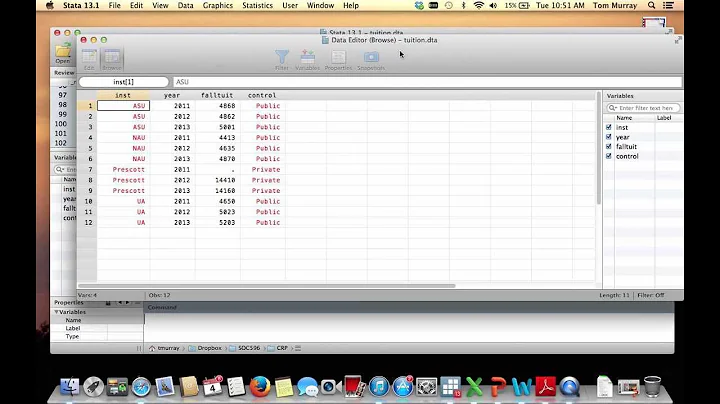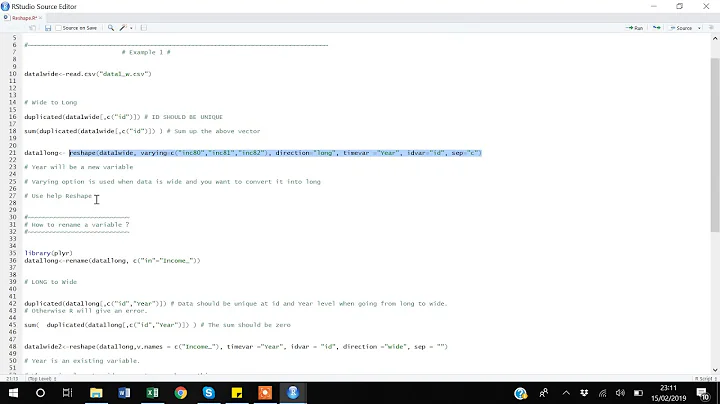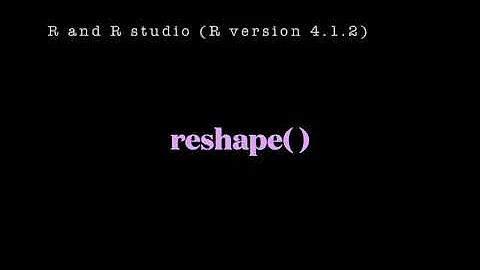Reshaping data.frame from wide to long format
Solution 1
reshape() takes a while to get used to, just as melt/cast. Here is a solution with reshape, assuming your data frame is called d:
reshape(d,
direction = "long",
varying = list(names(d)[3:7]),
v.names = "Value",
idvar = c("Code", "Country"),
timevar = "Year",
times = 1950:1954)
Solution 2
Three alternative solutions:
1) With data.table:
You can use the same melt function as in the reshape2 package (which is an extended & improved implementation). melt from data.table has also more parameters that the melt-function from reshape2. You can for example also specify the name of the variable-column:
library(data.table)
long <- melt(setDT(wide), id.vars = c("Code","Country"), variable.name = "year")
which gives:
> long Code Country year value 1: AFG Afghanistan 1950 20,249 2: ALB Albania 1950 8,097 3: AFG Afghanistan 1951 21,352 4: ALB Albania 1951 8,986 5: AFG Afghanistan 1952 22,532 6: ALB Albania 1952 10,058 7: AFG Afghanistan 1953 23,557 8: ALB Albania 1953 11,123 9: AFG Afghanistan 1954 24,555 10: ALB Albania 1954 12,246
Some alternative notations:
melt(setDT(wide), id.vars = 1:2, variable.name = "year")
melt(setDT(wide), measure.vars = 3:7, variable.name = "year")
melt(setDT(wide), measure.vars = as.character(1950:1954), variable.name = "year")
2) With tidyr:
library(tidyr)
long <- wide %>% gather(year, value, -c(Code, Country))
Some alternative notations:
wide %>% gather(year, value, -Code, -Country)
wide %>% gather(year, value, -1:-2)
wide %>% gather(year, value, -(1:2))
wide %>% gather(year, value, -1, -2)
wide %>% gather(year, value, 3:7)
wide %>% gather(year, value, `1950`:`1954`)
3) With reshape2:
library(reshape2)
long <- melt(wide, id.vars = c("Code", "Country"))
Some alternative notations that give the same result:
# you can also define the id-variables by column number
melt(wide, id.vars = 1:2)
# as an alternative you can also specify the measure-variables
# all other variables will then be used as id-variables
melt(wide, measure.vars = 3:7)
melt(wide, measure.vars = as.character(1950:1954))
NOTES:
- reshape2 is retired. Only changes necessary to keep it on CRAN will be made. (source)
- If you want to exclude
NAvalues, you can addna.rm = TRUEto themeltas well as thegatherfunctions.
Another problem with the data is that the values will be read by R as character-values (as a result of the , in the numbers). You can repair that with gsub and as.numeric:
long$value <- as.numeric(gsub(",", "", long$value))
Or directly with data.table or dplyr:
# data.table
long <- melt(setDT(wide),
id.vars = c("Code","Country"),
variable.name = "year")[, value := as.numeric(gsub(",", "", value))]
# tidyr and dplyr
long <- wide %>% gather(year, value, -c(Code,Country)) %>%
mutate(value = as.numeric(gsub(",", "", value)))
Data:
wide <- read.table(text="Code Country 1950 1951 1952 1953 1954
AFG Afghanistan 20,249 21,352 22,532 23,557 24,555
ALB Albania 8,097 8,986 10,058 11,123 12,246", header=TRUE, check.names=FALSE)
Solution 3
With tidyr_1.0.0, another option is pivot_longer
library(tidyr)
pivot_longer(df1, -c(Code, Country), values_to = "Value", names_to = "Year")
# A tibble: 10 x 4
# Code Country Year Value
# <fct> <fct> <chr> <fct>
# 1 AFG Afghanistan 1950 20,249
# 2 AFG Afghanistan 1951 21,352
# 3 AFG Afghanistan 1952 22,532
# 4 AFG Afghanistan 1953 23,557
# 5 AFG Afghanistan 1954 24,555
# 6 ALB Albania 1950 8,097
# 7 ALB Albania 1951 8,986
# 8 ALB Albania 1952 10,058
# 9 ALB Albania 1953 11,123
#10 ALB Albania 1954 12,246
data
df1 <- structure(list(Code = structure(1:2, .Label = c("AFG", "ALB"), class = "factor"),
Country = structure(1:2, .Label = c("Afghanistan", "Albania"
), class = "factor"), `1950` = structure(1:2, .Label = c("20,249",
"8,097"), class = "factor"), `1951` = structure(1:2, .Label = c("21,352",
"8,986"), class = "factor"), `1952` = structure(2:1, .Label = c("10,058",
"22,532"), class = "factor"), `1953` = structure(2:1, .Label = c("11,123",
"23,557"), class = "factor"), `1954` = structure(2:1, .Label = c("12,246",
"24,555"), class = "factor")), class = "data.frame", row.names = c(NA,
-2L))
Solution 4
Using reshape package:
#data
x <- read.table(textConnection(
"Code Country 1950 1951 1952 1953 1954
AFG Afghanistan 20,249 21,352 22,532 23,557 24,555
ALB Albania 8,097 8,986 10,058 11,123 12,246"), header=TRUE)
library(reshape)
x2 <- melt(x, id = c("Code", "Country"), variable_name = "Year")
x2[,"Year"] <- as.numeric(gsub("X", "" , x2[,"Year"]))
Solution 5
Since this answer is tagged with r-faq, I felt it would be useful to share another alternative from base R: stack.
Note, however, that stack does not work with factors--it only works if is.vector is TRUE, and from the documentation for is.vector, we find that:
is.vectorreturnsTRUEif x is a vector of the specified mode having no attributes other than names. It returnsFALSEotherwise.
I'm using the sample data from @Jaap's answer, where the values in the year columns are factors.
Here's the stack approach:
cbind(wide[1:2], stack(lapply(wide[-c(1, 2)], as.character)))
## Code Country values ind
## 1 AFG Afghanistan 20,249 1950
## 2 ALB Albania 8,097 1950
## 3 AFG Afghanistan 21,352 1951
## 4 ALB Albania 8,986 1951
## 5 AFG Afghanistan 22,532 1952
## 6 ALB Albania 10,058 1952
## 7 AFG Afghanistan 23,557 1953
## 8 ALB Albania 11,123 1953
## 9 AFG Afghanistan 24,555 1954
## 10 ALB Albania 12,246 1954
Related videos on Youtube
mropa
Updated on January 05, 2022Comments
-
mropa over 2 years
I have some trouble to convert my
data.framefrom a wide table to a long table. At the moment it looks like this:Code Country 1950 1951 1952 1953 1954 AFG Afghanistan 20,249 21,352 22,532 23,557 24,555 ALB Albania 8,097 8,986 10,058 11,123 12,246Now I would like to transform this
data.frameinto a longdata.frame. Something like this:Code Country Year Value AFG Afghanistan 1950 20,249 AFG Afghanistan 1951 21,352 AFG Afghanistan 1952 22,532 AFG Afghanistan 1953 23,557 AFG Afghanistan 1954 24,555 ALB Albania 1950 8,097 ALB Albania 1951 8,986 ALB Albania 1952 10,058 ALB Albania 1953 11,123 ALB Albania 1954 12,246I have looked at and already tried using the
melt()and thereshape()functions as some people were suggesting in similar questions. However, so far I only get messy results.If it is possible I would like to do it with the
reshape()function since it looks a little bit nicer to handle.-
Eduardo Leoni over 14 yearsDon't know if that was the problem, but the functions in the reshape package are melt and cast (and recast.)
-
 IRTFM over 9 yearsAnd the reshape package has been superseded by reshape2.
IRTFM over 9 yearsAnd the reshape package has been superseded by reshape2. -
 drhagen about 8 yearsAnd now reshape2 has been superseded by tidyr.
drhagen about 8 yearsAnd now reshape2 has been superseded by tidyr. -
 NelsonGon over 2 yearsAnd now
NelsonGon over 2 yearsAnd nowtidyr'sgatherandspreadhave been replaced bypivot_*functions.
-
-
Jason Goal over 6 yearsgreat answer, just one more tiny reminder : do not put any variables other than
idandtimein your data frame,meltcould not tell what you want to do in this case. -
 Jaap over 6 years@JasonGoal Could you elaborate on that? As I'm interpreting you comment, it shouldn't be a problem. Just specify both the
Jaap over 6 years@JasonGoal Could you elaborate on that? As I'm interpreting you comment, it shouldn't be a problem. Just specify both theid.varsand themeasure.vars. -
Jason Goal over 6 years,then that's good for me, don't know
id.varsand themeasure.varscan be specified in the first alternative,sorry for the mess, its my fault. -
 Admin over 4 yearsSorry to necro this post - could someone explain to me why 3 works? I've tested it and it works, but I don't understand what dplyr is doing when it sees
Admin over 4 yearsSorry to necro this post - could someone explain to me why 3 works? I've tested it and it works, but I don't understand what dplyr is doing when it sees-c(var1, var2)... -
 Jaap over 4 years@ReputableMisnomer When tidyr sees
Jaap over 4 years@ReputableMisnomer When tidyr sees-c(var1, var2)it omits these variables when transforming the data from wide to long format. -
 Admin over 4 yearsAh wow - what a neat trick. Truly a time saver. Was so resistant to move to the
Admin over 4 yearsAh wow - what a neat trick. Truly a time saver. Was so resistant to move to thetidyverse()yet it surprises me every day... -
 Darwin PC about 4 yearsmelt was the best option for me. Thanks a lot!
Darwin PC about 4 yearsmelt was the best option for me. Thanks a lot! -
Evan Rosica about 4 yearsAccording to the tidyverse blog
gatheris now retired and as been replaced bypivot_longer. They state: "Newpivot_longer()andpivot_wider()provide modern alternatives tospread()andgather(). They have been carefully redesigned to be easier to learn and remember, and include many new features. spread() and gather() won’t go away, but they’ve been retired which means that they’re no longer under active development." -
Evan Rosica about 4 yearsThis needs more upvotes. According to the Tidyverse Blog
gatheris being retired andpivot_longeris now the correct way to accomplish this. -
andschar almost 3 years@EvanRosica only until they decide to change the function again :p







